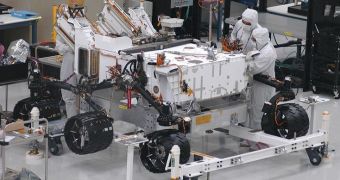Officials at the American space agency say that the Mars Science Laboratory now costs more than $2.5 billion, hundreds of millions of dollars more than initially estimated when the program began, in 2003.
While the sum may seem staggering at first, what needs to be considered here is the fact that the machine includes a series of new and innovative technologies, that were developed exclusively for it.
Additionally, this is the first nuclear-powered rover to be sent to another planet. The machine weighs nearly a ton, and is about the size of a Mini Cooper. It contains high-power lasers that can analyze rocks from up to 30 meters away, as well as ovens for analyzing biological samples.
The MSL will be deployed on the Martian surface via an innovative system called the Sky Crane, which has never been used before. For this rover, NASA constructed the largest parachute ever developed for a space mission.
At this point, the machine is scheduled to be launched this autumn, and to reach the Red Planet sometime in April 2012. If it is to launch in November, then NASA needs to come up with an additional $82 million cash infusion to give to the project.
Program fund reserves were exhausted at the end of last year. The money went on paying contractors, research&development for the new technologies, full-scale drop tests for the deployment system and other such essential aspects of the mission.
Overall, the $82 million that are now needed to respect the November deadline represent a 3 percent increase in budget, explains the director of the NASA Science Mission Directorate (SMD) Planetary Sciences Division, Jim Green.
The new funds are needed for fixing issues associated with the mobility systems, avionics, radar and drill that will go on the MSL rover, now nicknamed Curiosity. The rover needs to be delivered to the Cape Canaveral Air Force Station (CCAFS), in Florida, by June.
“Our problem right now is MSL. It has virtually no unencumbered reserves left,” Green told colleagues from the NASA Advisory Council planetary sciences subcommittee on January 26.
“That money's got to be identified and that money's got to be in the budget. At the end of the day if we don't use it all, then we have flexibility, but it's got to be there when we need it,” the official added, quoted by Space.
“The program office is on notice that they'll have to skinny down. We have little flexibility to cut back our operating missions […] although there is some. We'll have to see what's operating that should move on,” he concluded by saying.

 14 DAY TRIAL //
14 DAY TRIAL //